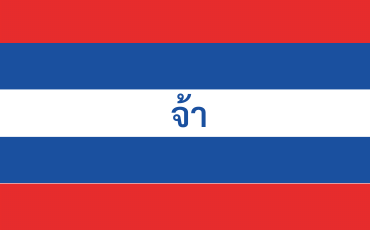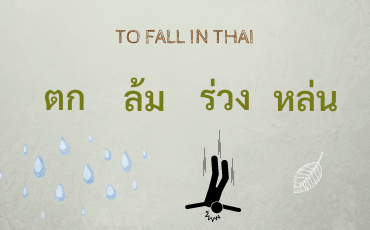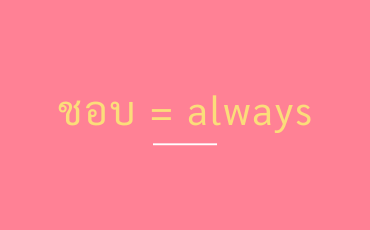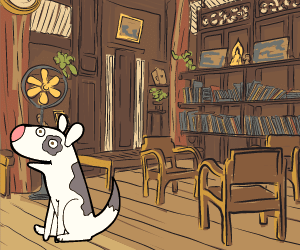จ้า (jâa) Ja in Thai can be used as a replacement for krap and ka. In case you don't know, Krap and Ka are particles you add at the end of sentences to sound polite and friendly. If you want to sound more friendly, and/or more like a rural Thai person, you should try...
Blog
Different ways to say to fall in Thai
In Thai Language, there are a few ways to say to drop or to fall. I will explain the different ways and when to use each. 💡 Keep in mind that a lot of times the word ลง (long) is added after the vocabulary meaning "to fall" because ลง means down. So it's like saying...
How to express whoever, whenever, wherever, whatever, whichever, however in Thai
The question words in Thai ใคร (krai), เมื่อไร (mêua rai), ที่ไหน (têe năi), อะไร (à-rai), ไหน (năi), อย่างไร (yàang rai) (who, when, where, what, which, how) can become whoever, whenever, wherever, whatever, whichever, and however depending on the sentence. Let me...
Plural form in Thai
When you want to change a word from singular to plural in English, most of the time you just add an s at the end (kid => kids, horse => horses, laptop => laptops). There are exceptions such as child =>children, woman => women). Thai language does not...
Difference between Gao and Kuan (เกา, ข่วน) | How to say to scratch in Thai
I was asked by my Thai Student "What is the difference between เกา and ข่วน?" (gao and kùan). They both mean to scratch but there is a difference. ข่วน ข่วน (kùan) means scratch when you get scratched by an animal such as a cat, lion, tiger, etc. Think of the "claws"...
How to ask What is your name in Thai?
"What is your name?" is a question you will ask and get asked often in Thailand. Let's learn how to say it. What is your name In Thai? What is your name in Thai is คุณชื่ออะไร (kun chêu à-rai). Literally: You name what? Let's break it down. คุณ kun = You...
Telling directions in Thai
In this article, I will teach you important words you need to know when you want to tell directions. This will be useful for you when you get in a taxi, travel around Thailand, ask for directions, etc. Let's go! Important vocabulary เลี้ยวlíeowto...
What is the Thai Wai (ไหว้) and how to do it
If you have traveled in Thailand, you must have seen people greeting each other by putting their hands together (as if they were praying) and slightly bowing their head. This is called a Wai. In this article, I will teach you what the Thai Wai (ไหว้) is, how to do it,...
A meaning of ชอบ you might not have known (Advanced Thai tips)
I bet everyone knows that ชอบ (chôp) means "to like". But did you know ชอบ is also frequently used in colloquial Thai to mean "always"? It makes sense if you think about it (you'll understand why soon), and usually the only way to tell if ชอบ means to like or always...
Meaning of มั้ง and how to use it
You probably know that maybe in Thai is อาจจะ (àat jà). But did you know มั้ง máng is another colloquial way of saying "maybe"? It adds a degree of uncertainty. มั้ง máng means maybe, not sure, perhaps. It's a very Thai way of saying maybe. The formula is to put มั้ง...
What does สู้ๆ mean?
I bet you have seen or heard Thai people saying สู้ๆ (sôo sôo) in many situations. But do you actually know what สู้ๆ means and when are appropriate situations to use it? The meaning of สู้ๆ สู้ๆ literally translates to "fighting fighting" however the real uses of...
Prepositions of place in Thai
Let's learn some prepositions of place in Thai such as on, in, below, in front of, behind, between, etc. ข้าง (kâang) and ด้าน (dâan) both mean "side". So, in the following examples, you will see different ways to say the same thing. บน (bon) = on top of/above The dog...












